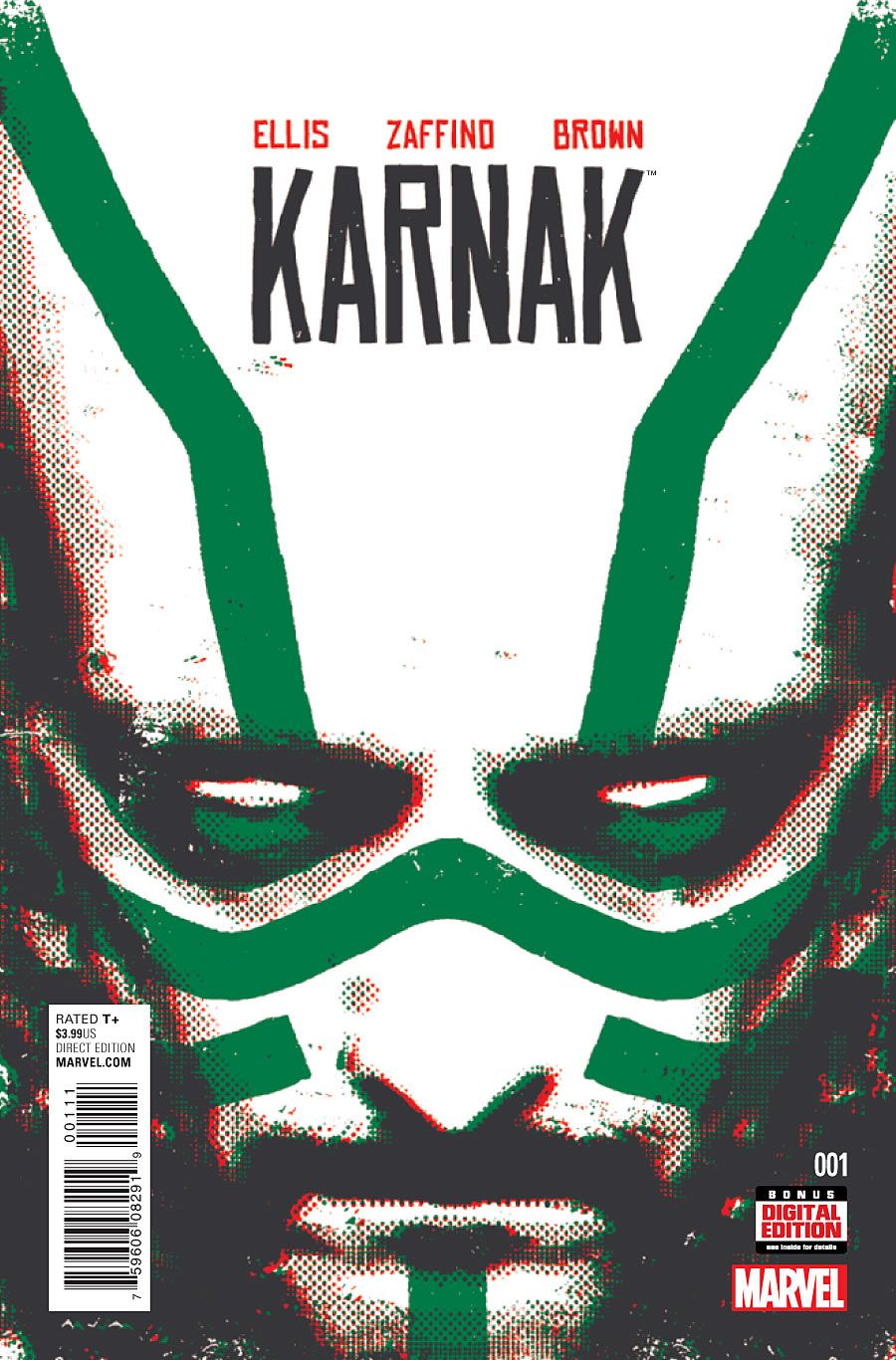Warren Ellis and Gerardo Zaffino's "Karnak" #1 is the solo series debut for a character created all the way back in 1965 by none other than Lee and Kirby. Karnak is getting a bigger stage as part of Marvel's aggressive push of the Inhumans franchise. Karnak, an oddball even among his tribe, is an Inhuman without superpowers, who acquired his abilities through discipline and sheer force of will. He's a good fit for Ellis, who has done well with characters that are intense, opinionated and solitude-seeking.
"Karnak" #1 shares a lot with Ellis' recent relaunch and run on "Moon Knight," both in content and tone. The main character is an antihero and loner, and the story is mission and action-oriented, with a veneer of mysticism and philosophy for flavor. Both heroes are brutal, efficient and skilled in martial arts. They both possess blunt manners of speech, little regard for societal norms and a limited range of emotional affect, moving along a continuum from angry to amused. They both have style and make a strong first impression, and are set apart from kin and cronies.
The opening scene is a brilliant introduction, introducing the reader to Karnak's monk-like existence in the Tower of Wisdom and letting the exposition occur through the art and the dialogue. The second scene brings in Agents Coulson and Simmons, and -- despite the Arctic setting -- the two are still a blast of pure warmth in terms of tone. The conversation between Coulson and Simmons is inherently funny from the opening line of "Aren't you cold, Phil?" to the brilliant punchline as the party moves inside. Ellis writes Coulson's dialogue very well, evoking the rhythms of actor Clark Gregg's casual, quick-speaking speech patterns and making the character feel instantly familiar and likeable. Ellis' wit also shines in later scenes, when Karnak finds the logic of S.H.I.E.L.D's bureaucratic red tape "insane" as well as when he explains earnestly how he learned how to make an impression through his study of cinema. The humor here is deliciously meta and ironic and the deadpan delivery is perfectly paced.
Coulson is necessary to the humor, and his presence also defines the main character through contrast. Coulson's relatability and compassion provide a foil to Karnak's menace and mystery. It was a smart move on Ellis' part to involve S.H.I.E.L.D. for the sake of bringing Coulson and Karnak into each other's orbits, even if the reasons are ridiculous even to the characters.
Zaffino's artwork in "Karnak" #1 is ambitious and beautiful. He manages to create a gritty look even with an incredibly fine line. Throughout "Karnak" #1, he uses screentone effects to suggest supernatural or mystical energy, layering it over very fine linework. The first page almost looks like it's a Tarot card full of symbols, with the vulture, the Tower and the mountains creating a paradoxical atmosphere of calm and menace. The screentone in the sky is applied unevenly to suggest a light haze of particles in the air.
The quality of Zaffino's mark-making is wonderful, particularly the angular, spare, tense silhouettes of his figures. Even the still shots of buildings have tension. Zaffino can really draw. Each panel pays attention to shape and to the frame. Karnak's cloak and ninja hand wraps drape naturally and are full of movement. His foreshortening in the final, silent action sequence is daring and convincing, except for on the final page, where Karnak's left leg looks disproportional in size and too rigid.
In the opening scene, Dan Brown's choices of pale, luminous yellows and greens make Zaffino's figures and backgrounds shine. However, the middle scenes in the S.H.I.E.L.D. substation are too dominated by purplish gray, and the muddy purples and oranges on the last page aren't his best work either. Still, his sensibility feels like a good match.
The only potential issue is that, as the story develops, the limited emotional range of the hero may forestall serious character development and emotional depth. Ellis' run "Moon Knight" was always surprising and visually fascinating, but the main character remained closed off to the reader. In Karnak's case, Coulson's involvement may mitigate that. Whether or not that's the case, "Karnak" #1 still is must-read for its art and sharp wit.

